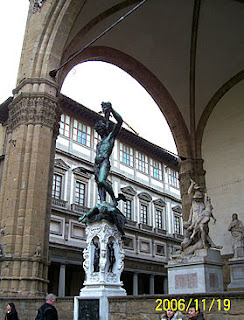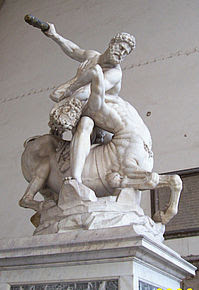
The Loggia dei Lanzi, also called the Loggia della Signoria, is a building on a corner of the Piazza della Signoria in Florence, adjoining the Uffizi Gallery. It consists of wide arches open to the street, three bays wide and one bay deep. The arches rest on clustered pilasters with Corinthian capitals. The wide arches appealed so much to the Florentines, that Michelangelo even proposed that they should be continued all around the Piazza.
It was built between 1376 and 1382 to house the assemblies of the people and hold public ceremonies. Today it is effectively a marvellous open-air sculpture gallery of antique and Renaissance art.
In this first picture the statue in front depicts the Rape of the Sabine Women by the Flemish artist Jean de Boulogne, better known as Giambologna. This impressive work was made from one imperfect block of white marble, the largest block ever transported to Florence.

On the steps of the Loggia are two Marzoccos, marble statues of lions, heraldic symbols of Florence. This one on the left was sculpted by Flaminio Vacca in 1598. It was originally placed in the Villa Medici in Rome, but found its final place in the Loggia in 1789.
Beyond the lion we can see the front of the Palazzo Vecchio.

Underneath the bay on the far left is the bronze statue of Perseus by Benvenuto Cellini, the most famous work in the Loggia, and probably his best bronze sculpture. Beyond the sculture we see the corner of the Uffizi Gallery (Galleria degli Uffizi).
The scuplture shows the mythical Greek hero holding his sword in his right hand and holding up triumphantly the Medusa's decapitated head in his left. The well-proportioned muscular body of Perseus stands poised on the right leg. Perseus is subdued, holding back his emotions. Blood is gushing from the head and the neck of the dead Medusa. The richly decorated marble pedestal, equally by Cellini, shows four graceful bronze statuettes of Jupiter, Mercurius, Minerva and Danae.

And here we have Hercules killing that mythical beast, a centaur, and another view of the Rape of the Sabine Women.

The name Loggia dei Lanzi dates back to the reign of Grand Duke Cosimo I, when it was used to house his formidable landsknechts (in Italian: "Lanzichenecchi", corrupted to Lanzi), or German mercenary pikemen. After the construction of the Uffizi at the rear of the Loggia, the Loggia's roof was modified and became a terrace from which the Medici princes could watch ceremonies in the piazza.

No comments:
Post a Comment